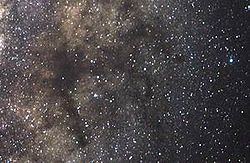Right ascension 17 21 Distance ?? ly Radius ?? ly | Declination −21° 07′ Apparent dimensions (V) ?? Designations Great Dark Horse | |
 | ||
Similar Pipe Nebula, Snake Nebula, Little Ghost Nebula, Barnard 68, Epsilon Ophiuchi | ||
The Dark Horse Nebula or Great Dark Horse (sometimes called The Prancing Horse) is a large dark nebula, which as seen from Earth, obscures part of the upper central bulge of the Milky Way. The Dark Horse lies in the equatorial constellation Ophiuchus (the Serpent Bearer), near its borders with the more famous constellations Scorpius and Sagittarius. It is a significant, visible feature of the Milky Way's Great Rift.
Contents
Name
This region of dark nebulae is called Dark Horse because it resembles the side silhouette of a horse and appears dark as compared with the background glow of stars and star clouds. It is also known as "Great" because it is one of the largest (in apparent size) groups of dark nebulae in the sky.
Nearby Nebulae
The rear of The Great Dark Horse (its rump and hind legs), is also known as the Pipe Nebula, which itself carries the designation B77, B78, and B59. (The 'B' numbers named after the astronomer Edward Emerson Barnard, who catalogued dark nebulae.) The Snake Nebula (B72) is by comparison a small S-shaped nebula emerging from the west side of the northern part of the bowl of the Pipe (B77).
The ability to see The Great Dark Horse with the naked eyes is an indication that the skies are very dark, i.e. not affected by (urban and industrial) light pollution.
